Dinosaurs of the Hell Creek
© PaleoAdventures.com

The Latest Cretaceous, Hell Creek and Lance Formations are some of the most fossil-rich rock units in the United States, if not the world. Every year, both public and private groups travel to Montana, Wyoming, North Dakota and South Dakota in pursuit of these remains and every year they return with new skeletons, isolated elements and teeth. These important fossils have helped change the way we look at dinosaur anatomy, physiology, ecology, evolutionary history and of course, the end Cretaceous-Paleogene extinction event.
The Hell Creek and the Lance Formations are generally considered to be equivalent terrestrial units. That is to say, that they were deposited at approximately the same time during the Maastrictian epoch, approximately 66-67 million years ago, along the eastern margin of the primordial Rocky Mountains. Despite a few structural and localized faunal differences, they are sedimentologically very similar. They typically consist of alternating, “somber-colored” (tan to grey to maroon), fluvially deposited, conglomerates, sandstones, siltstones, shales, mudstones, freshwater limestones, minor coal seams and the occasional volcanic ash bed, rich in bentonite. Yellow, red-brown to orange to even, black, siderite-limonite iron concretions and secondary concretionary horizons are very common. Like most fluvial systems, it is highly variable. Unlike the overlying Paleocene, Tullock or Ludlow members of the Fort Union Formation, which often have laterally continuous beds and thicker coal seams, the Hell Creek and the Lance shift depositional environments rather quickly leading to a more chaotic look and feel. The Hell Creek Formation tends to be more rich in mudstones and carbonaceous shales, whereas the Lance tends to have more fine grained sandstones and siltstones. The Hell Creek is on average, around 90-100 meters thick (Murphy et. al 2002; Depalma 2010), whereas the Lance is further south and west, closer to the source of the sediment, and thus, considerably thicker. Some estimates suggest that the Lance can be over 600 meters thick in some of the interior mountain basins of Wyoming.
The Lance Formation was first named and officially described by John Bell Hatcher in 1903 for exposures along Lance Creek, Wyoming. Prior to this time it was simply referred to as the “ceratops beds”. Important expeditions related to its description or to collections from it, include the: Hayden and Meek surveys of of the 1850's and 1870s; the Hatcher expeditions of 1890-1893, The University of Wyoming expeditions of the 1950's -1960's, The University of California Berkeley expeditions of the 1950's to 1970's (Clemmens and Hartman, 2014), as well as dozens of both public and private teams which come out each and every year.
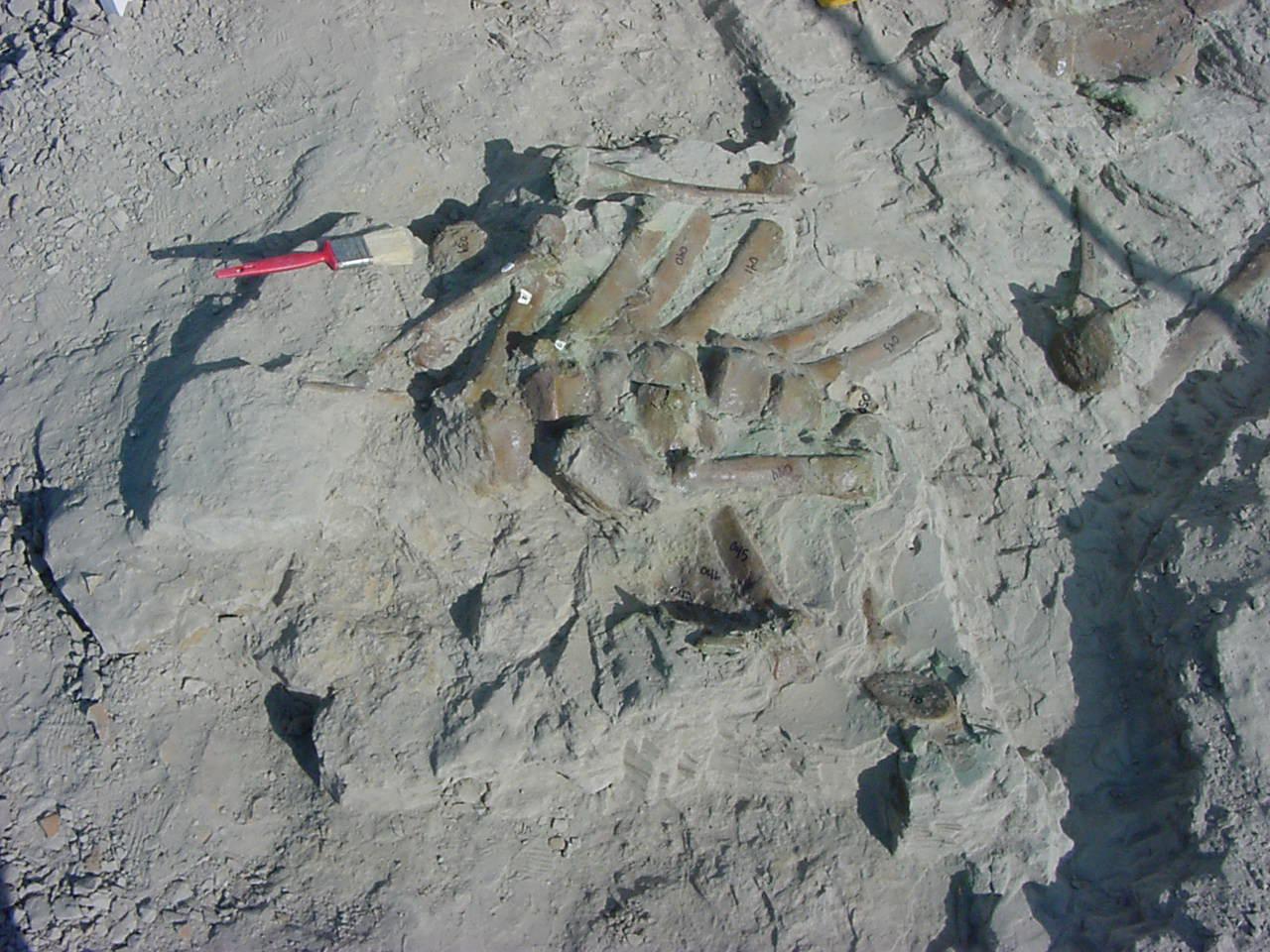
The Hell Creek Formation was not formally described until 1907, by Barnum Brown for exposures along Hell Creek, several miles north of Jordan, MT. Important explorations include those made in the 1850's by Hayden and Meek, and of course, those made by Brown himself between 1900 and 1910. Additional major expeditions included: The Science Museum of Minnesota expeditions of the early 1960's, the LA County Museum of Natural History expeditions of the mid 1960's to 1970's, the UCCP expeditions of the 1970's-early 2000's (Clemmens and Hartman, 2014), the Museum of the Rockies, Hell Creek Dinosaur Project from 1999-2010 (Horner et. al., 2010; 2014) and the Marmarth Research Foundation expeditions of the late 1990's and early 2000's. Work on the South Dakota side of the line continued with explorations by the South Dakota School of Mines and Technology throughout the 1980's and 1990's, the Black Hills Institute expeditions of the 1980's to today, and the Triebold Paleontology expeditions of the mid 1990's to present. At present, there are at least 60 different museums, science centers, universities, commercial collectors, ranchers and private collectors which dig and explore these units annually.
These formations represent an ancient coastal floodplain environment, filled with swamps, low-land forests, estuaries, broad, but shallow, river systems and occasional lakes. As the Rockies slowly rose to the west, the Hell Creek and Lance Formation expanded eastward, filling in the great basin that was the Western Interior Seaway. Along this irregular, swampy coastline, dinosaurs flourished.
To date, over 20 different genera of dinosaurs have been found with new specimens discovered each year. The ceratopsians are represented by at least three genera; Triceratops, Torosaurus, and Leptoceratops. An additional two others, Tatankasaurus and an unnamed ceratopsian may also exist, though the latter has yet to be formally described and debated. Hadrosaurs are represented by several species of Edmontosaurus and possibly by a rare genus known as Anatotitan. Thescelosaurus is the primary small ornithopod, but there has been some isolated evidence to suggest the possibility of another unknown Hypsilophodontid. Pachycephalosaurs are represented by up to four genera. These include Pachycephalosaurus, Stigimoloch, Dracorex and Sphaerotholus. Some, including (Horner,) have suggested that only one of these, Pachycephalosaurus, is valid. The armor plated dinosaurs are represented by at least two genera; Ankylosaurus (an ankylosaurid) and Denversaurus, (a nodosaurid) though this material is surprisingly rare. Tyrannosaurs are represented by the super predator, Tyrannosaurus and the always controversial, Nanotyrannus. Struthiomimus appears to be the lone Ornithimimid, but the Oviraptorosaurs may include up to three separate genera. These include the recently described Anzu, the enigmatic Leptorhyncos, and two, smaller undescribed specimens. Dromaeosaurs are represented by at least two and possibly up to five genera. These include the recently named Acheroraptor and Dakotaraptor as well as cf. Saurornitholestes, Richardoestesia and another undescribed genera known only from teeth. Troodontids include two genera known only from teeth and very rare, isolated elements. These include: cf. Troodon and Pectinodon. Additional enigmatic small theropods known from either fragmentary material or teeth include: an undescribed Alvarezsaurid and Paronychodon (which may or may not be a dinosaur). Of all of these genera, only ten remain undisputed and known from reasonably complete skeletons. These include: Triceratops, Edmontosaurus, Thescelosaurus, Pachycephalosaurus, Ankylosaurus, Denversaurus, Tyrannosaurus, Struthiomimus, Dakotaraptor and Anzu. The rest are known from very fragmentary remains, teeth or are disputed for one reason or another.
Other time equivalent formations include the Frenchman and Scollard Formations of Canada, the Laramie and Ferris Formations of southern Wyoming, the Denver Formation of Colorado, and the McRae Formation of New Mexico. Together, this entire group of rock formations outcrop sporadically over 1,200 miles along the front range of the Rockies and along the outer rims of the inter-montane basins of the western United States and Canada. For the purpose of this study, only the Hell Creek and Lance Formations of Wyoming, Montana, South Dakota and North Dakota are considered. Fossils contained in these beds represent some of the last dinosaurs to exist on the planet prior to the great K-Pg mass extinction.
The following is a partial list of different types of dinosaurs that might be found in the Hell Creek or Lance Formations:

Triceratops- The most common dinosaur encountered in the Late Cretaceous Hell Creek and Lance Formation is Triceratops. This large ceratopsian reached a length of over 30 feet long and weighed up to 10 tons. It was built like a bull or rhino and had a battering ram for a skull. Like the name implies it had three horns on its face… two large (3-4 feet long at maturity) horns on its brow and one shorter one on its nose. It also had a bony frill that covered the back of its neck that may have helped protect it from attack or make it look larger to frighten its enemies. This frill may have been brightly colored or displayed a unique pattern which helped it attract mates, locate members within the herd or help scare off would be challengers. These dinosaurs had a vice like bite and powerful jaws designed for chewing on very tough vegetation. Based on a handful of bone beds where many individuals have been found (common in other ceratopsians, but rare in Triceratops), they most likely traveled in large herds in the more upland and open regions of the Hell Creek ecosystem. As of 2017, at least 300 partial skeletons and skulls have been found since its discovery in the late 1800's. They are known from at least two species: T. horridus which had a shorter more compact skull and lower, nose horn, and T. prorsus, which had a longer skull and a very large forward projecting nose horn.
Torosaurus- One of the rarer genera in the Hell Creek ecosystem was Torosaurus aka the “bull lizard”. Isolated specimens of Torosaurus are often misidentified as Triceratops as their skeletons are very similar. What separates the two genera are significant differences in the skull. Torosaurus has a longer face and skull with two large fenestra in its frill. Fenestra are holes which helped to lighten the weight of the skull, without decreasing its overall size or display prowess. Some researchers have suggested that Torosaurus is simply an older, more mature Triceratops and not a valid genera in and of itself. Others disagree.
Tatankasaurus- Known from only a single partial skeleton, Tatankaceratops remains an enigmatic ceratopsian on most lists. If valid, it represents a very rare, small-morph, chasmosaurine that most likely inhabited a sub-environment different than Triceratops. It is characterized by short, dorsally projecting brow horns that are nearly equal in size to its nose horn as well as a much smaller adult size. Most researchers suspect that it represents a dwarf or juvenile form of Triceratops (Ott and Larson, 2010) .
Leptoceratops- Leptoceratops was a small, 5-6 ft. long, primitive ceratopsian with a short face, no horns and a small frill. Several skulls and specimens are known from Late Cretaceous rock formations in Canada, but very few remains (teeth and the rare skull element) have been found in the Hell Creek or Lance. Like the last three ceratopsians, its bones and teeth are often misidentified as the more common Triceratops.
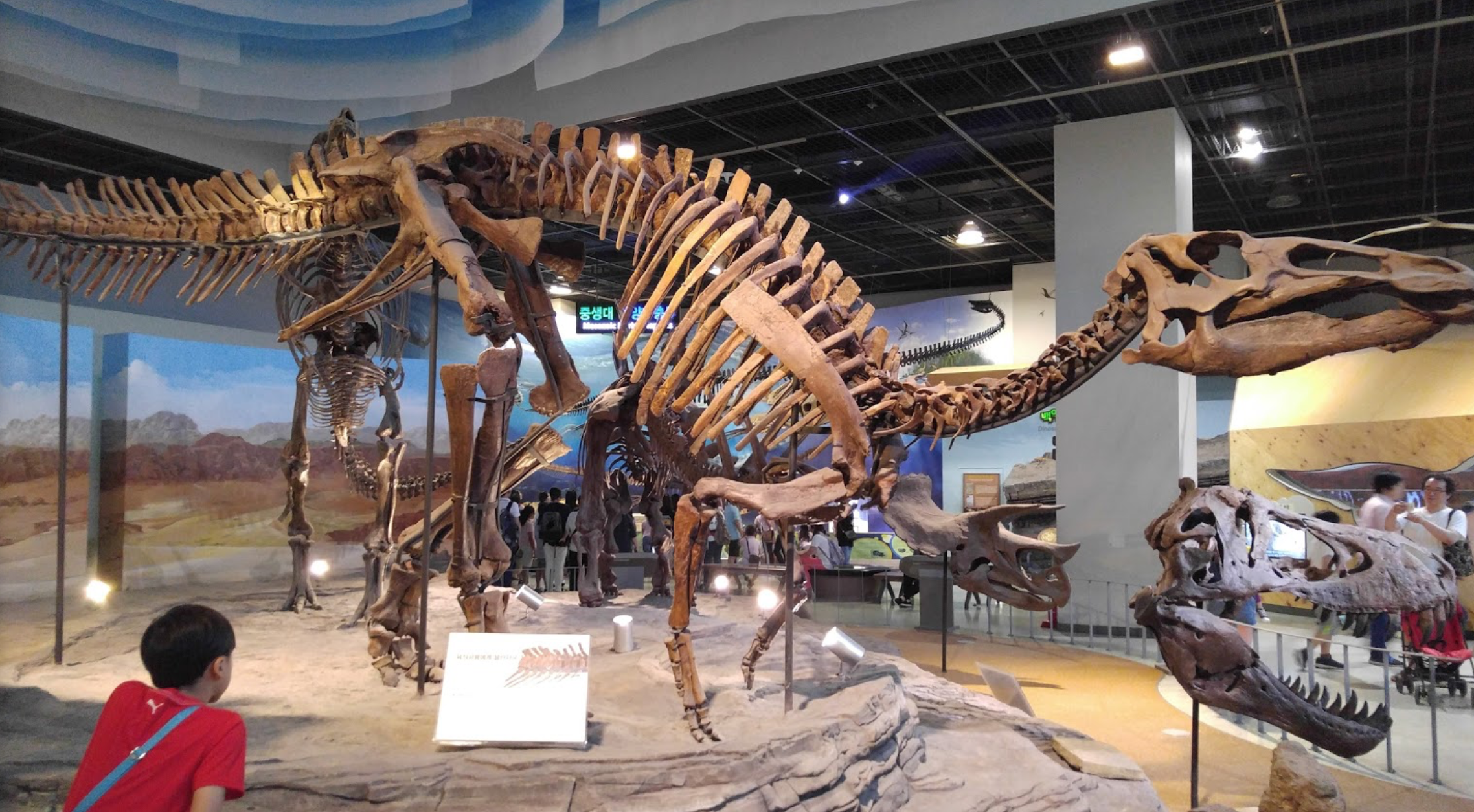
HADROSAURSIDAE
Edmontosaurus- This was a duckbilled dinosaur very common to the Late Cretaceous rocks of North America. It could reach a length of just over 40 feet long, but average skeletons are generally between 25 and 35 feet long. This is a plant eater that more than likely traveled in large herds across the floodplain. Often, thick bone beds consisting of hundreds of individuals have been found, indicating a gregarious or herding behavior. Isolated, highly abraded Edmontosaurus bones are frequently found on our dig sites in South Dakota, Wyoming and Montana. Worn or shed teeth from this animal are commonly found in micro sites all across the Lance and Hell Creek Formation.
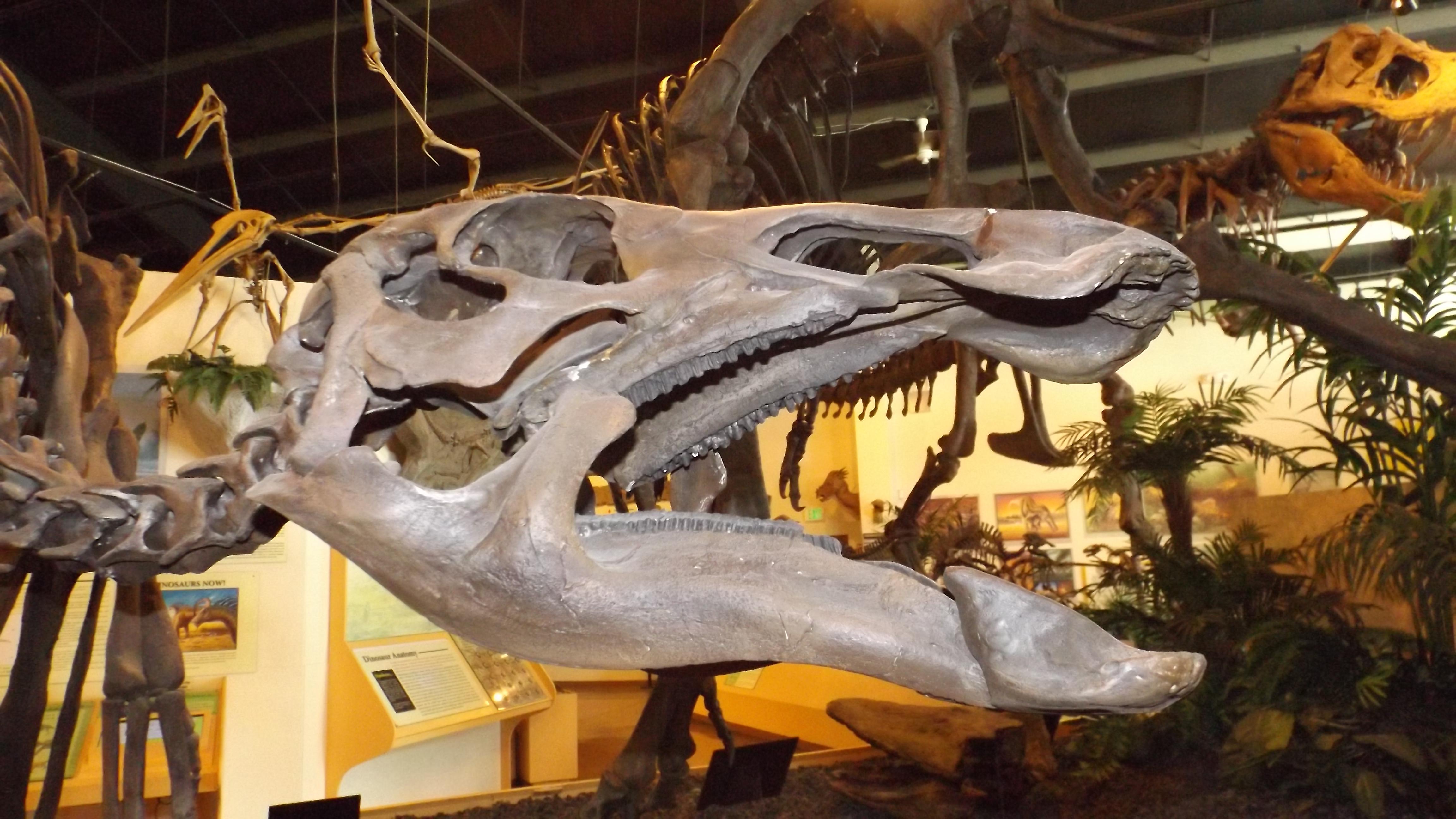
Anatotitan- Anatotitan was a very large, hadrosaurine (no crest), duckbilled dinosaur closely related to Edmontosaurus. The few specimens that are attributed to it are diagnosed predominantly by its large, elongated skull and larger frame. Many researchers consider these differences as ontogenic or individual variation... not enough to designate it as a separate genus. If valid, Anatotitan was a more rare dinosaur, possibly inhabiting a more upland environment. Like Leptoceratops above, its post-cranial bones would frequently be misidentified as Edmontosaurus.

THESCELOSAURIDAE
Thescelosaurus- Thescelosaurus was a small to mid-sized plant eater common to the Late Cretaceous. It was built like and looked very much like a young hadrosaur, but differences in its skull and skeleton set it apart., most notably in its dentition. Thescelosaurs have their teeth set in sockets as opposed to a massive tooth battery. They also have a longer, more lightly built body and tail which may have enabled it to move more freely in the denser forests and swamps of the Hell Creek ecosystem. Thescelosaurus is much rarer than Edmontosaurus as only 29 partial skulls and skeletons have been found. One of the most famous Thescelosaurus ever found was discovered about 35 minutes northwest of our main quarries, on a private ranch in Harding County, SD. This specimen, nick-named “Willow” had very rare soft tissue preservation. Inside its chest cavity was what some have suggested to be a fossilized four chambered heart!


PACHYCEPHALOSAURIDAE
Pachycephalosaurus- Pachycephalosaurus, or “Thick-headed lizard”, was a large, 9-12 foot long, dome-headed (head shaped like a football helmet), dinosaur that wandered the ancient Hell Creek forests 66 million years ago. Based on its dentition, it was most likely an omnivore feeding on a variety of both plants and animals. It's skull, as the name implies, was large and well rounded and might have been used for interspecies head-butting over territory or mates. There are only a handful of good skulls and isolated bones of this animal, so it was most likely a more solitary animal.
Stigimoloch- Stigimoloch was another enigmatic dome-headed dino with a slightly smaller skull, but had more horns and hornlets than Pachycephalosaurus. Clearly the two are very closely related leading many scientists to conclude that specimens refereed to it are simply juvenile Pachycephalosaurus and not a valid genera. It's also possible that Pachycephalosaurus and Stigimoloch are good examples of sexual dimorphism... same genus and species just different morphologies between males and females.
Dracorex- One of the coolest and most bizarre dinosaurs to grace the Hell Creek and Lance ecosystem was Dracorex. This dinosaur is very rare, known from only a single complete skull and a few isolated bits. The skull though is very different from any of the other pachycephalosaurs. It has multiple sharp horns and hornlet clusters (more than any of the others), and has two fenestra where the dome should be. Like all Pachys it was most likely an omnivore.
Sphaerotholus- The smallest of the four possible pachys was Sphaerotholus. This petite pachycephalosaur is known only from a handful of isolated fronto-parietal domes. The domes and what little else of the skull has been found are dense and rounded and slightly different from that of Pachycephalosaurus.

ANKYLOSAURIDAE
Ankylosaurus- Ankylosaurus was a giant armadillo like, armor-plated dinosaur that lumbered about the Hell Creek floodplains over 65 million years ago. It was built like a tank, low to the ground and very powerful. Embedded in its skin were hundreds of large osteoderms, also called scutes. These bony scales helped protect the animal from attack from any lightly built theropod that may have considered it a meal. It ate plants and most notably had a bony club on the end of its powerful tail that it could swing as a weapon. The force of being hit by an Ankylosaurus club in full swing would have been tremendous and quite the deterrent for any would-be attacker. Skeletons and isolated bones and teeth from this genera are very rare. Only a handful of good skeletons and skulls exist, so it either preferred a habitat that was not conducive to preservation, or it was a rarely scene animal… even back then.
NODOSAURIDAE
Denversaurus- A medium sized, armor plated dinosaur that was closely related but distinct from Ankylosaurus. Unlike, its larger cousin, Denversaurus (sometimes identified as Edmontonia), had a long tail that did not end in a club. Instead, Denversaurus had very large shoulder spikes and dense lateral scutes designed to ward off any would-be predators. There have only been a few skeletons of Denversaurus in the Hell Creek and Lance. More often, one finds only a pile of associated scutes.
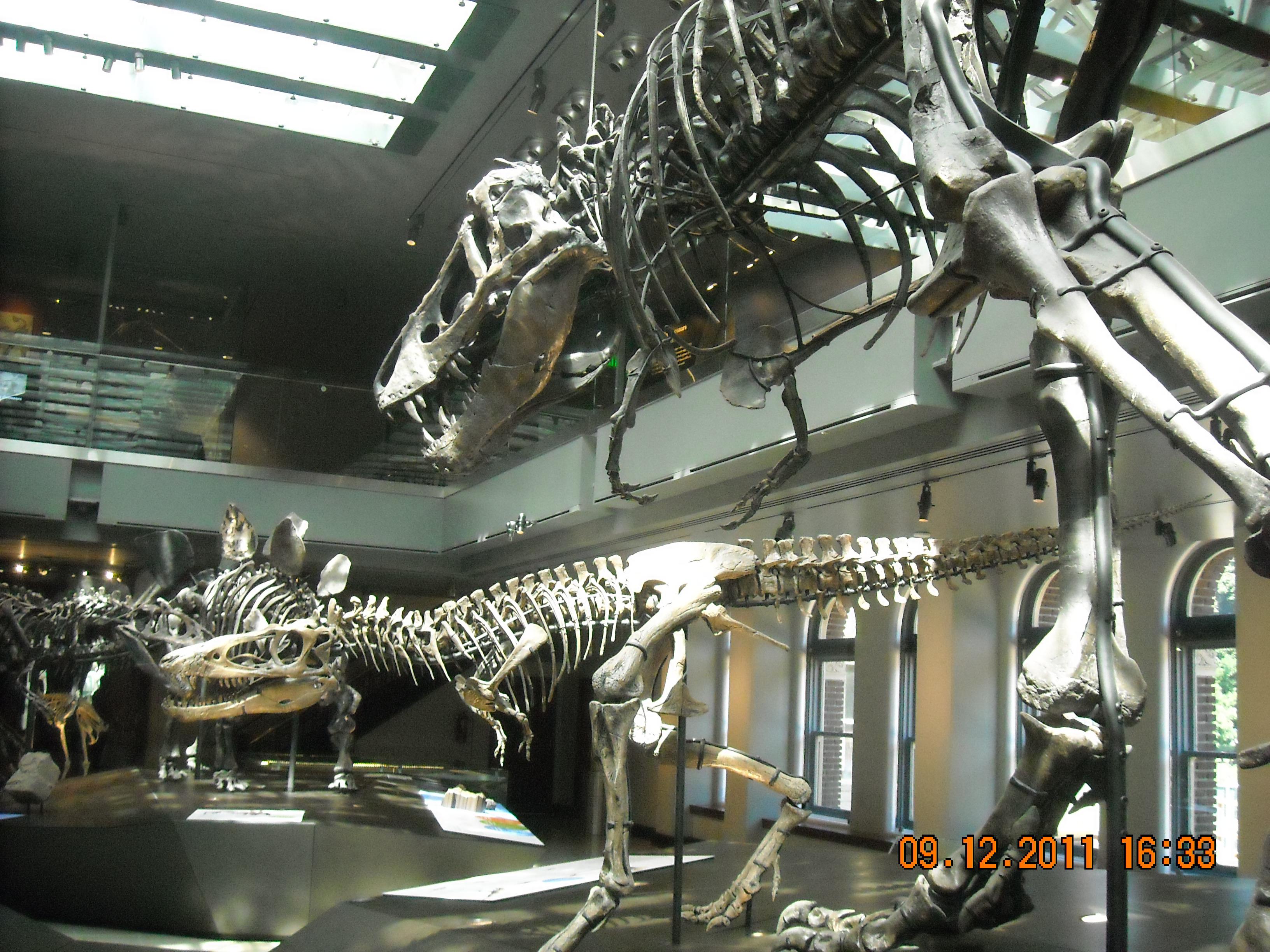
TYRANNOSAURIDAE
Tyrannosaurus- This magnificent super-predator was the most highly advanced large-scale theropod of its day. Full grown adults could reach a length of over 45 feet and weight between 6-9 tons. They had a 5-6 foot long skull with over 50 stout, banana-shaped teeth designed, not just for slicing meat from bone, but for crushing and breaking bone. Tyrannosaurus was an active, warm-blooded, hunter feeding upon any dinosaurs that may have crossed its path. They most likely targeted young or injured hadrosaurs, but based on fossil evidence, occasionally targeted younger or weaker Triceratops that they could cut from the herd. Tyrannosaurs were certainly not light on their feet, and built for more long range jogging, but when pressed, could still reach a top speed of over 15 miles/hour. This was certainly fast enough to catch most plant eaters of the day. As expected, Tyrannosaurus is a bit more rare. To date, at least 70 partial associated/articulated skulls and/or skeletons are known to exist. The most complete (90%) was called “Sue” and she was found about 60 miles east of our main quarries. The second most complete (65%) was called Stan which was found about 45 miles west of our quarries.
Nanotyrannus- Nanotyrannus, or the “pygmy tyrant”, was a mid-sized carnivore that lived during the late Cretaceous right alongside the magnificent Tyrannosaurus. The two animals were both very similar and both members of the Tyrannosauridae. They are so closely related, that many paleontologists have argued that specimens attributed to Nanotyrannus are simply juvenile morphs of Tyrannosaurus. While this is certainly a possibility, major morphological differences in the skull, jaws, dentition, forearms, and pelvis, suggest that it is indeed something separate. Nanotyrannus was a more lightweight and nimble predator that may have filled an ecological niche separate from the more stoutly built Tyrannosaurs. Nano's may have been able to inhabit denser portions of the forested floodplains and target smaller prey light pachycephalosaurs and thescelosaurs. Teeth of Nanotyrannus are quite common and are frequently found in large numbers near Edmontosaurus skeletons suggesting that Nanos may have hunted in small family units or even packs. Skeletons and isolated bones from this animal, however, are incredibly rare, so its status is still highly debated.
Nanotyrannus- Nanotyrannus, or the “pygmy tyrant”, was a mid-sized carnivore that lived during the late Cretaceous right alongside the magnificent Tyrannosaurus. The two animals were both very similar and both members of the Tyrannosauridae. They are so closely related, that many paleontologists have argued that specimens attributed to Nanotyrannus are simply juvenile morphs of Tyrannosaurus. While this is certainly a possibility, major morphological differences in the skull, jaws, dentition, forearms, and pelvis, suggest that it is indeed something separate. Nanotyrannus was a more lightweight and nimble predator that may have filled an ecological niche separate from the more stoutly built Tyrannosaurs. Nano's may have been able to inhabit denser portions of the forested floodplains and target smaller prey light pachycephalosaurs and thescelosaurs. Teeth of Nanotyrannus are quite common and are frequently found in large numbers near Edmontosaurus skeletons suggesting that Nanos may have hunted in small family units or even packs. Skeletons and isolated bones from this animal, however, are incredibly rare, so its status is still highly debated.

ORNITHOMIMIDAE
Struthiomimus- Perhaps the fastest of all the Late Cretaceous dinosaurs, this ostrich-like dinosaur had hollow, but heavily built bones with a body that was similar to an ostrich. Its skull was toothless and may have eaten mostly plants. Even though it had a long, s-curved neck and small skull with no teeth, it shared a distant common ancestor with Tyrannosaurus. To date there are at least 18 known partial skeletons of this genera that have been found in the Hell Creek and Lance Formations. Isolated bones of Struthiomimus are infrequently found, indicating that it may not have been as large a component in this ecosystem as it was in other older rock units.

CAENAGNATHIDAE
Anzu- One of the most bizarre dinosaurs to grace the Hell Creek ecosystem was Anzu, a giant form of North American Oviraptor. It had a large crest on its skull and toothless jaws making it look very similar to today's modern cassowary bird. Like the cassowary, it had very powerful legs and sharp claws on its feet. Unlike the cassowary, it sported longer arms tipped with sharp talons that might have been used for defense, display or for digging after burrowing prey. This animal was most likely am omnivore and ate a wide variety of plants, animals and invertebrates. It is known from only six partial specimens and dozens of isolated elements.
Leptorynchos- A smaller cousin of Anzu known only from partial foot bones.
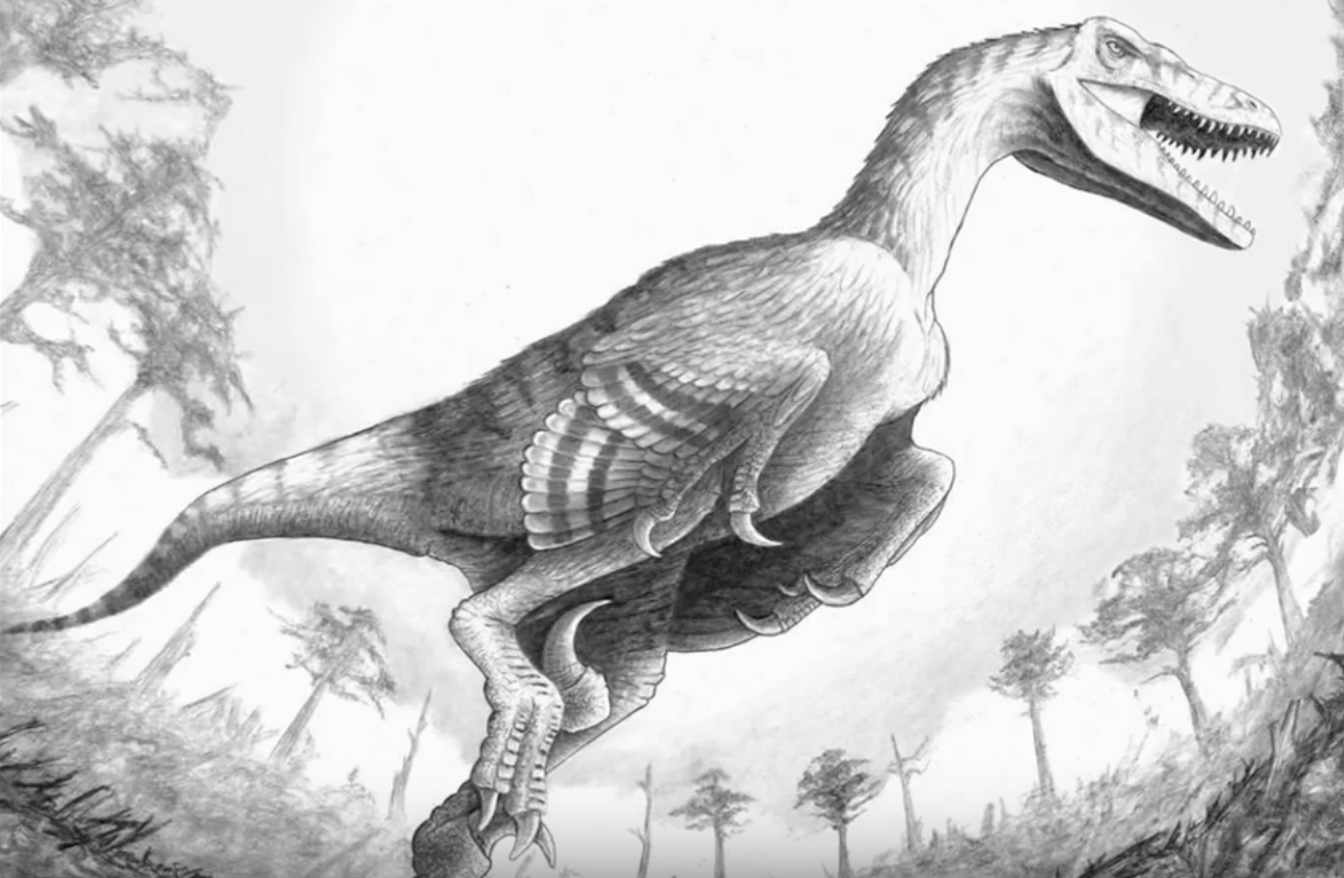
DROMAEOSAURIDAE
Dakotaraptor- One of the newest and coolest dinosaurs to be discovered from the depths of the Hell Creek Formation was Dakotaraptor. This exceptionally large raptor may have reached a length of over 18 feet long and would have been a terrifying sight to see during the Late Cretaceous. Like its other raptor cousins, it had an enlarged 2nd ungual or “killing claw” which it could use to bring down its prey. To date, there is only one known, very fragmentary skeleton of this genera, though its teeth are frequently found at our sites. One of the really interesting aspects of this dinosaur is that it's formlimb bone (ulna) was preserved with tiny bumps called quill knobs. This indicates that like its smaller Asian cousins, Dakotaraptor was feathered and very bird like.
Acheroraptor- Acheroraptor was a fast, light-weight, vicious predator that had a much smaller maximum size and build. It most likely hunted in packs and used its signature, sickle shaped killing claw on its hind feet to kill its prey. They were very bird-like animals with light-weight hollow bones. Just like its Asian cousins, it was most likely covered in a fine mat of feathers. All of this is really only a best guess however, as it is only known from a partial skull (only two bones), a handful of isolated remains that might be from it and a large supply of isolated teeth.
Saurornitholestes- Associated/Articulated specimens of Saurornitholestes have occasionally been found in older rock units in Canada and Montana, but no specimens other than isolated teeth and possible bones have been found in the Hell Creek/Lance. Teeth of this small raptor are often found while screening debris.
Richardoestesia (gilmorei)- Richardoestesia was most likely the smallest of all the known Hell Creek/Lance raptors. These, are currently, known only from teeth, with a distinct shape and very fine serrations. There have been two species related to this genus, R. gilmorei and R. isoceles. Both have a distinct morphology and it is very likely that R. isoceles is not from a raptor at all.

TROODONTIDAE
cf. Troodon- Thought to be one of the smartest dinosaurs based on its brain/bodyweight ratio, this small raptor light animal is known only from a handful of partial skeletons found in earlier rock units. Isolated bones sometimes found in the Hell Creek.
Pectinodon- A very small Troodontid known only from teeth with a very diagnostic serration.
UNKNOWN SMALL THEROPODS
Paronychodon- Paronychodon is one of the great mysteries of the Hell Creek and Lance Formations. There has never been any skulls or skeletal material discovered that can be directly attributed to it, but its teeth are quite common in many deposits. These teeth are ridged and very diagnostic. It is quite possible that Paronychodon is not a dinosaur at all, but an unknown genus of pterosaur.
Zapsalis- With weird, ridged teeth with flatten side, Zapsalis teeth stand out like sore thumbs. These may be from another small raptor or possibly a different tooth morph for the genus Paronychodon.
cf. Alvarezsaurid- Alvarezsaurids are very unusual group of long-legged, swift, bird-like, small theropods. They had highly modified hands, which end in a single, very diagnostic claw. The purpose of this one claw is unknown. Their jaws are lightly built and full of very fine, serrated teeth. To date, they are only known from the very rare, isolated bone though many of the smaller, serrated mystery raptor teeth may be from this.